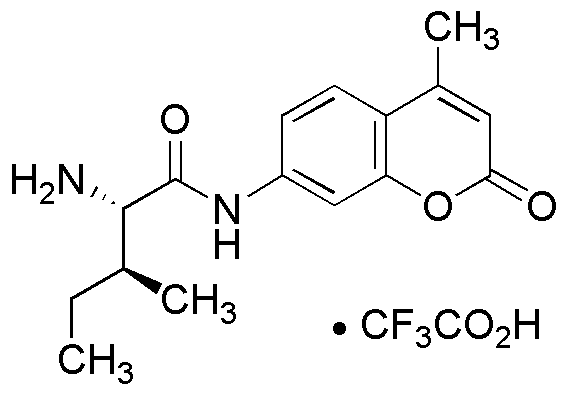L-Isoleucine 7-amido-4-methylcoumarin trifluroacetate is widely utilized in research focused on:
- Fluorescent Probes: This compound serves as a fluorescent probe in biochemical assays, allowing researchers to visualize and track biological processes in real-time.
- Drug Development: It plays a crucial role in the design of new pharmaceuticals, particularly in targeting specific proteins or enzymes, enhancing drug efficacy.
- Bioconjugation: The chemical is employed in bioconjugation techniques, linking biomolecules for therapeutic and diagnostic applications, which is essential in personalized medicine.
- Peptide Synthesis: It is used in the synthesis of peptides, providing a means to create complex molecules for research in molecular biology and biochemistry.
- Research in Metabolism: The compound aids in studying metabolic pathways, offering insights into amino acid metabolism and its implications in various diseases.
General Information
Properties
Safety and Regulations
Applications
L-Isoleucine 7-amido-4-methylcoumarin trifluroacetate is widely utilized in research focused on:
- Fluorescent Probes: This compound serves as a fluorescent probe in biochemical assays, allowing researchers to visualize and track biological processes in real-time.
- Drug Development: It plays a crucial role in the design of new pharmaceuticals, particularly in targeting specific proteins or enzymes, enhancing drug efficacy.
- Bioconjugation: The chemical is employed in bioconjugation techniques, linking biomolecules for therapeutic and diagnostic applications, which is essential in personalized medicine.
- Peptide Synthesis: It is used in the synthesis of peptides, providing a means to create complex molecules for research in molecular biology and biochemistry.
- Research in Metabolism: The compound aids in studying metabolic pathways, offering insights into amino acid metabolism and its implications in various diseases.
Documents
Safety Data Sheets (SDS)
The SDS provides comprehensive safety information on handling, storage, and disposal of the product.
Product Specification (PS)
The PS provides a comprehensive breakdown of the product’s properties, including chemical composition, physical state, purity, and storage requirements. It also details acceptable quality ranges and the product's intended applications.
Certificates of Analysis (COA)
Search for Certificates of Analysis (COA) by entering the products Lot Number. Lot and Batch Numbers can be found on a product’s label following the words ‘Lot’ or ‘Batch’.
Numéro de catalogue
Numéro de lot/série
Certificates Of Origin (COO)
This COO confirms the country where the product was manufactured, and also details the materials and components used in it and whether it is derived from natural, synthetic, or other specific sources. This certificate may be required for customs, trade, and regulatory compliance.
Numéro de catalogue
Numéro de lot/série
Safety Data Sheets (SDS)
The SDS provides comprehensive safety information on handling, storage, and disposal of the product.
DownloadProduct Specification (PS)
The PS provides a comprehensive breakdown of the product’s properties, including chemical composition, physical state, purity, and storage requirements. It also details acceptable quality ranges and the product's intended applications.
DownloadCertificates of Analysis (COA)
Search for Certificates of Analysis (COA) by entering the products Lot Number. Lot and Batch Numbers can be found on a product’s label following the words ‘Lot’ or ‘Batch’.
Numéro de catalogue
Numéro de lot/série
Certificates Of Origin (COO)
This COO confirms the country where the product was manufactured, and also details the materials and components used in it and whether it is derived from natural, synthetic, or other specific sources. This certificate may be required for customs, trade, and regulatory compliance.


